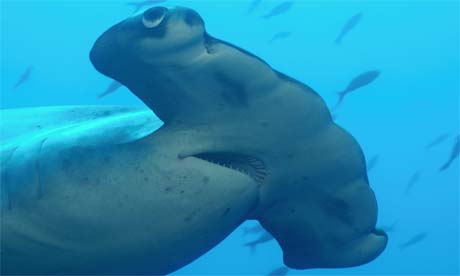See other Science/Tech Articles
Title: Shark species face extinction amid overfishing and appetite for fins
Source:
http://www.guardian.co.uk/
URL Source: http://www.guardian.co.uk/environment/2008/feb/18/conservation.aaas
Published: Feb 17, 2008
Author: Alok Jha in Boston
Post Date: 2008-02-17 21:57:33 by robin
Keywords: None
Views: 109
Comments: 2
Call for marine reserves to protect migration hotspots as scientists fear decline will affect other species
A scalloped hammerhead shark. Photograph: Stephen Frink/Corbis
Nine more species of shark are to be added to the endangered list as scientists warn that oceans are being emptied of the fish by overfishing and finning.
The scalloped hammerhead shark, which has declined by 99% over the past 30 years in some parts of the world, is particularly vulnerable and will be declared globally endangered on the World Conservation Union (IUCN) list.
"Sharks are definitely at the top of the list for marine fishes that could go extinct in our lifetimes," said Julia Baum of the Scripps Institution of Oceanography in California and a member of IUCN shark specialist group. "If we carry on the way that we are, we're looking at a really high risk of extinction for some of these shark species within the next few decades."
At the American Association for the Advancement of Science annual meeting in Boston yesterday, Baum said that in addition to the scalloped hammerhead, other shark species that will be added to the revised IUCN endangered list later this year are the smooth hammerhead, shortfin mako, common thresher, big-eye thresher, silky, tiger, bull and dusky. There are already 126 species of shark on the IUCN's list
"The perception has been that really wide-ranging species can't become endangered because if they are threatened in one area, surely they'll be fine in another area," said Baum. "But fisheries now cover all corners of the earth and they're intense enough that these species are being threatened everywhere."
Recent studies have shown that all shark populations in the north-west Atlantic Ocean have declined by an average of 50% since the early 1970s.
Shark numbers can become depleted very quickly because they take a long time to mature - 16 years in the case of a scalloped hammerhead. Their fins are highly prized in China and can fetch up to £140 a kilogram. Until recently the eating of shark fin was a delicacy restricted to the rich in China, said Baum, but as the country's middle class has grown in the past 25 years, so has the market for shark fins
Excessive fishing has caused a 90% decline in shark populations across the world's oceans and up to 99% along the US east coast, which are some of the best-managed waters in the world, according to Baum
The decline in predators such as sharks can have devastating consequences for the local marine ecology.
In a case study published last year, Baum found that a major decline in the numbers of predatory sharks in the north Atlantic after 2000 had allowed populations of the sharks' prey, cownose rays, to explode. The rays in turn decimated the bay scallop populations around North Carolina. "There was a fishery for bay scallops in North Carolina that lasted over a century uninterrupted and it was closed down in 2004 because of cownose rays."
Fishing for sharks in international waters is unrestricted, but Baum supports a recent UN resolution calling for immediate limits on catching sharks and a ban on shark finning.
Sonja Fordham, of the Shark Alliance, a coalition of 50 scientific and conservation groups, said: "People think these wide-ranging, fast sharks are resilient to fishing; however, this shows this is not the case. Concerned citizens can really help by making their fisheries ministers aware that they support conservation measures such as catch limits."
Some conservation efforts for sharks will focus on newly identified hotspots where sharks congregate during migrations. Peter Klimley of the University of California, Davis, found that scalloped hammerhead sharks migrate along fixed "superhighways" in the oceans, speeding between a series of "stepping stone" sites near coastal islands ranging from Mexico to Ecuador.
"Hammerhead sharks are not evenly dispersed throughout the seas, but concentrated at seamounts and offshore islands," he said. "Hence, enforcing reserves around these areas will go far in protecting these species and will provide the public with places for viewing sharks in their habitat."
One site between Hawaii and Mexico attracts so many sharks it has become known among scientists as "the white shark cafe", Klimley says
"We started calling it the cafe because that is where you might go to have a snack or maybe just to 'see and be seen'. We are not sure which," said Salvador Jorgensen, a researcher at Stanford University's Hopkins Marine Station.
"Once they leave the cafe they return year after year to the same exact spot along the coast, just as you might return to a favourite fishing hole."

Post Comment Private Reply Ignore Thread
Top • Page Up • Full Thread • Page Down • Bottom/Latest
#1. To: robin (#0)
Does anyone else ever get the feeling like the ultimate fate of about 98% of all living things on this planet is to eventually be eaten by Chinese?
 | Gold and silver are REAL money, paper is but a promise. |
#2. To: Elliott Jackalope (#1)
snickering
Does anyone else ever get the feeling like the ultimate fate of about 98% of all living things on this planet is to eventually be eaten by Chinese?
Why do we fall sir? So we can learn to pick ourselves up. -- Alfred, Batman Begins
Top • Page Up • Full Thread • Page Down • Bottom/Latest